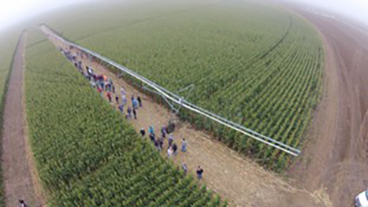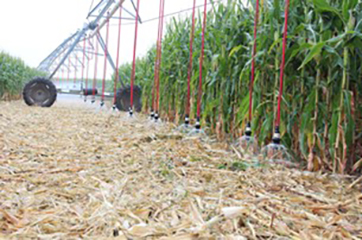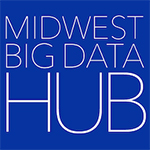By Francie Fink
This story is part of a series on partnerships developed by the Midwest Big Data Innovation Hub with institutions across the Midwest through the Community Development and Engagement (CDE) Program.
The Ogallala Aquifer is an incredible feat of nature—a fresh groundwater resource that underlies eight states, or 174,000 miles. The Ogallala contains sediments deposited by flowing water six million years ago. Water percolates through the layer of hardened sediments and settles, recharging the aquifer’s groundwater layer. Since the early 1900s, humans have tapped the Ogallala’s underground reserves for water. The aquifer has become in many ways the backbone of the High Plains, a subregion of America’s Great Plains. Kansas is one state that still relies heavily on the Ogallala’s water. The livelihood of those in Western Kansas, in particular, are tied to the aquifer, as most of Eastern Kansas uses surface water for agricultural practices.
Problems arise when the rate of water withdrawal from the aquifer exceeds the rate of its recharge. The “thickness”—that is, the level of water—of the aquifer varies geographically. In Kansas, water levels have dropped, on average, 28.2 feet since the mid-20th century. By 2100, 24% of Kansas’ land could run out of water entirely. It’s not so surprising, then, that perhaps no other user group is more concerned with the rate of water withdrawal from the Ogallala than farmers. In Kansas, it’s both folks who produce crops and folks who raise livestock that have a stake in the water-conservation effort. That’s because these two industries depend on each other. In plain terms, “cows need food to eat.” At the core of the Ogallala water-level issue is irrigation—the practice of watering crops—in this case, with groundwater. The more efficient a farmer’s use of water, the lower the rate of depletion. But regulations governing water in Kansas are complicated. Most notably, as per the state’s Water Appropriation Act, all farmers using water for irrigation are required by law to obtain a permit and report yearly water usage or else pay a hefty fine and perhaps forfeit their water allocations for the following year. In times where water is scarce, the more senior permit holders have first dibs on water.
The North Plains Groundwater Conservation District’s (NPGCD) Master Irrigator (MI) Program trains and educates producers on advanced conservation practices in irrigation. The program began in Texas and has since expanded to Oklahoma and Nebraska. The 32-hour curriculum of the full MI program focuses on water and energy conservation and doesn’t sacrifice producers’ goal of profit maximization. The blueprint of this program is well known to Kansas State University’s (K-State) Kansas Center for Agricultural Resources and the Environment (KCARE), where director Suzan Metzger and irrigation specialist Jonathan Aguilar have long sought a venue and curriculum that allows producers and processors to share regionally specific best practices for irrigation. But developing a Kansas-specific full MI Program requires extensive time and resources. The K-State team wanted to get the conversation started right away.


Pictured Left: Field day in western Kansas, where the public was invited to visit a working farm to see recommended irrigation technology in practice. Photo Credit: Grace Roth, Kansas State University.
Pictured Right: Pivot nozzles used for water conservation in irrigation systems. Photo Credit: Grace Roth, Kansas State University.
Metzger’s team partnered with the Midwest Big Data Innovation Hub (MBDH) to develop their own program, called “Master Irrigator Lite.” This bite-sized, day-long event was introduced in February 2024 to (1) engage producers and processors in best-practice sharing for irrigation and (2) establish a steering committee to plan curriculum for future iterations of the MI Program in Kansas.
“MI Lite was intended to spur the interest of the producers. It was a shorter version of what the full program would be,” said Aguilar, Professor and Water Resource Engineer at Kansas State University. “We tried to understand what producers are doing already and asked what they would like to see if the full program was implemented in Kansas. Producers are eager to implement something similar to what other states are doing, but Kansas will have a slightly different flavor than other states, in part because we are so data rich.”
Participants and program staff spoke on lots of water-related topics at the MI Lite Program, but conversation centered around one particular water-conservation practice, called the “Q-stable approach” to irrigation. Remember how Kansas has so many regulations around agricultural water use? A benefit of that system, although it is complex, is that the Kansas Geological Survey (KGS) uses data from mandated water meters to determine and map aquifer levels across the state. The KGS uses reported water usage to determine how far off a district, county, or township is, on average, from pumping water at a sustainable rate. That annual water usage that results in a sustainable pumping rate is called the Q-stable rate (in acre-feet per year). The methodology takes into account water inflows (recharging the aquifer) and outflows (pumping). Geographies are categorized as either above or below the Q-stable rate, and individual water usage can be benchmarked against the goal Q-stable rate for the next year. This evidence-based approach to water management is both effective and easy to adopt. While new water-saving nozzles and evaporation-reduction technology can be useful, it involves investment and substantial operational changes.
“The value that the Ogallala Aquifer has and continues to bring to all Kansans is unmeasurable,” says program participant and farmer, Brant Peterson. “For generations it has been the lifeblood of the economy as well as the people that drive the economy. We have a responsibility to our previous and future generations to make some changes to ensure the life of the aquifer.” Peterson continued, “The Kansas Master Irrigator Lite event I attended was exciting to see a regional group that was focused on coming up with workable solutions to conserve water and sustain economic viability for everyone.”
The MI Lite Program was a success, according to its participants and program coordinators. Twenty-two livestock and row-crop producers and processors from Western Kansas came for a full day of practice sharing, panel discussions, and networking. Several other regional partnerships were represented at the event, including the Kansas Geological Survey, Kansas Department of Agriculture, and Groundwater Management District 3. Overall, participants were energized by the peer learning. A post-event survey showed promising results for the continuation of this learning and practice sharing. All participants said that the event helped them to learn more about local hydrology and how water use impacts the Ogallala Aquifer, and 60% of participants indicated they were interested in serving on an advisory committee for the future of the MI Program in Kansas. The K-State team is now hoping to host a series of distinct workshops for farmers that will give them “microcredentials” in the Q-stable methodology and other water-conservation practices.
Learn More/Get Involved
Learn more about Kansas State’s Master Irrigator Lite Program here.
Contact the Midwest Big Data Innovation Hub if you’re aware of other people or projects we should profile here, or to participate in any of our community-led Priority Areas. The Midwest Big Data Innovation Hub is an NSF-funded partnership of the University of Illinois at Urbana-Champaign, Indiana University, Iowa State University, the University of Michigan, the University of Minnesota, and the University of North Dakota, and is focused on developing collaborations in the 12-state Midwest region. Learn more about the national NSF Big Data Hubs community.
